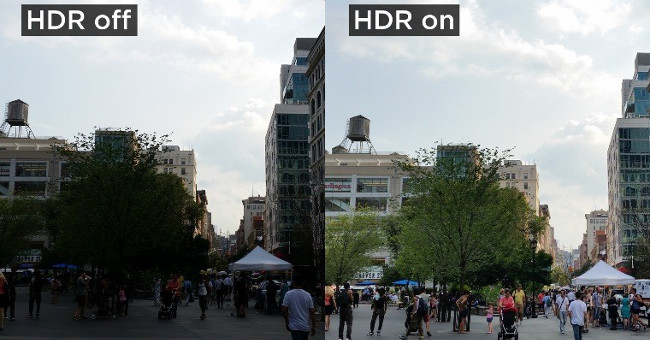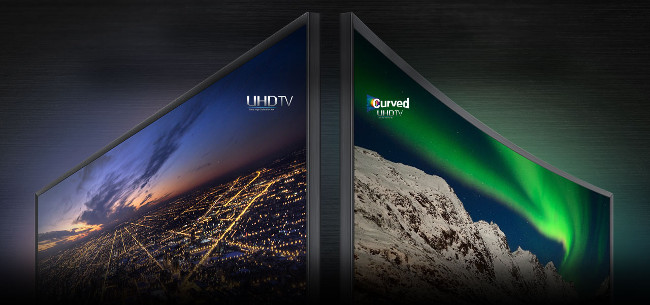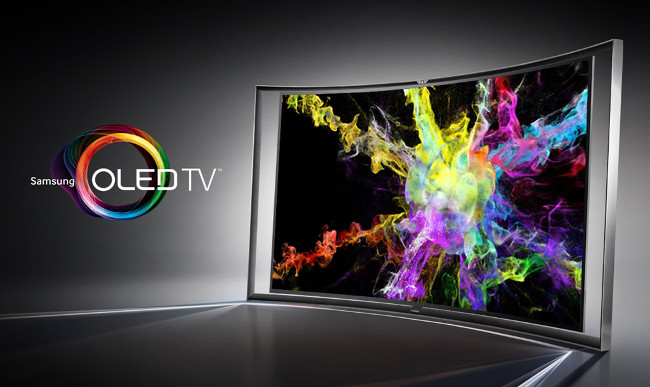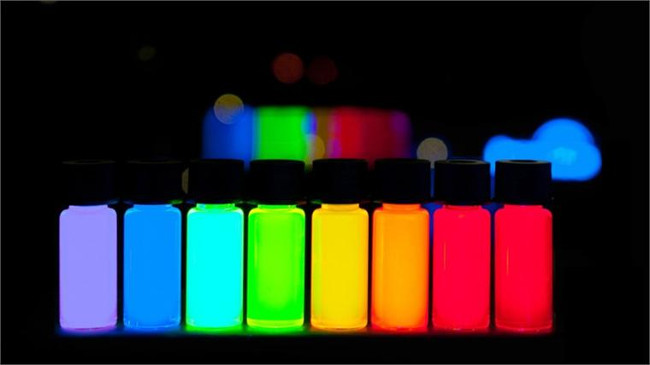So and should not care what technologies on TV
At present, there are many models and designs of television in the market, which are very rich and diverse, so choosing a quality television is also a headache problem for consumers, because Modern TVs have a lot of parameters, technology is difficult to understand and if you are not knowledgeable about technology then you certainly do not understand what it is. So the article below TipsMake.com would like to send you some aspects of TV technology when going to buy and should not care.

SUHD technology TVs will be better than UHD technology, what is the S in " SUHD " and really better HDR technology than 4K? What is the difference between technologies like 4K, HDR, OLED, UHD, SUHD, UHDBD and others, or are they just different in letters?
All the above symbols are the terms for technology that displays the screen that the TV owns, to distinguish the technology on each product and make sure they all have advantages or disadvantages.
1. HDR technology

HDR stands for High Dynamic Range , roughly translated as extended dynamic contrast range . New technology on today's TVs for the ability to display colors, brightness as well as higher contrast than conventional TVs.
HDR technology brings a lot of interesting things to viewers, but the term is quite abused on television, so an alliance includes film producers, TV stations, technology companies. Established, they evaluated a HDR television that will be labeled UHD Premium, especially for Sony TVs that do not use this label, but instead call their own name 4K 4K. Technically the two labels are the same, both for standard TVs.
2. 4K and Ultra HD (UHD)
Basically, 4K and UHD are the same, both of which are the terms used to describe the latest high-definition TVs on the market today. For example, HDTV is the only TV with 1920x1080 pixel resolution, 4K and UHD are 4 times larger than HDTV, with a resolution of 3840x2160 pixels.

However, high resolution is not what determines the quality of a television, it's just a small aspect of a television set. If you want to have a good quality TV, you need to consider good contrast ratio or accurate color gamut to give you the best TV experience .
3. What is local dimming?
This is the local darkening technology on TV but few people know it and understand it. Most TVs on the market today use LED backlighting on LCDs, and these backlight panels are not able to turn off the display light at certain locations that can only be turned on or off.

LED Local dimming is different, this backlight type is capable of turning off completely at locations where pixels display black. The turn-on time is also very short, does not affect the image quality on your LCD. However, not all intermediate or high-end TVs own Local dimming.
4. OLED
As mentioned above, most of the TVs on the market are LED LCDs and some of LG's models use OLED - Organic Light-Emitting Diode technology.

OLED display shows a deeper black color than LED, OLED pixels self-illuminate when electric current is passed, thus saving electricity, low heat output. The OLED display offers good display quality, wider LED color range, excellent contrast and extremely high scanning levels.
5. SUHD

SUHD is a new UHD-based technology for Samsung's high-end TV series that uses a new panel with a color filter made of Nano Crystal. Is exclusive technology with good quality, safe with 3 layers of protection against harmful, oxidized, non-toxic metal Cadmium.
In addition, SUHD possesses 64 times wider color band than UHD TV by using 10-bit panel instead of 8-bit panel, which helps reproduce more than 1 billion shades to make images more realistic and detailed than conventional UHD TVs .
6. Technology Quantum dots and Nano crystals
Quantum dots, also known as quantum dot technology , allow LCD displays to produce colors using color filters. It's basically tiny strips of plastic in red, green and green. As their colors become darker, the image will become more realistic. Quantum dots are tiny particles that glow a certain color, are particularly effective and are added to the substrate of an LED TV or a similar display. Quantum dots are really good at displaying colors, reproducing true colors but their price is much higher and is used for high-end television lines.

As for Nano Crystals, we mentioned above, is the exclusive technology on Samsung TV series, using 10bit base plate to provide image quality, 64 times more color than Ultra HD technology (UHD). .
7. Entertainment content 4K standard Blu-ray
With owning good quality TVs, high resolution 4K, UHD or SUHD, you also need to have quality movies with you. Currently 4K quality movies are not rare but are still not popular, the current TV content still stops at HD. Only a few services offer 4K content like Netflix, Amazon or Vudu. In some LG TVs when you buy, you will be offered a free month of Netflix.
The current drawback is whether or not the speed of the data line meets the Blu-ray standard 4K movies, and instead you can also enjoy entertainment with FullHD movies. With today's TV technology, the standard FullHD movie size up-scale to 4K still provides good image quality, not inferior to 4K movies.
You should read it
- MyTV Multiscreen - the perfect multi-screen feature on the rise of technology television
- What's special about 8K TV? The hottest 8K TV series today
- Techniques of choosing to buy television sets .... NET
- 7 mistakes to make when cleaning the TV screen
- Instructions to block ads on Smart TV
- Should the TV screen be too bright?
- Why must I set the correct date and time for Smart TV?
- Harmful myths when adjusting the TV definition
May be interested
- 10 'survival' technologies are indifferent
 we live in a marvelous world, with the siege of modern technology. but rarely do we stop to think about the technologies that we still use every day, even if it lacks it for a few moments, we'll be crazy. below l & agrav
we live in a marvelous world, with the siege of modern technology. but rarely do we stop to think about the technologies that we still use every day, even if it lacks it for a few moments, we'll be crazy. below l & agrav - How to take care of yourself when you are sick
 knowing how to take care of yourself when you are sick is a basic life skill. this article will provide you with useful information on how to make yourself feel better when you are sick.
knowing how to take care of yourself when you are sick is a basic life skill. this article will provide you with useful information on how to make yourself feel better when you are sick. - Fret select LCD screen - CRT
 it is a fierce competition between one side and new technologies that are constantly developing and on the one hand are old but not backward technologies.
it is a fierce competition between one side and new technologies that are constantly developing and on the one hand are old but not backward technologies. - Simple ways to keep your liver healthy
 your liver is the largest organ in your body and is responsible for hundreds of essential jobs. so take good care of your liver before it's too late.
your liver is the largest organ in your body and is responsible for hundreds of essential jobs. so take good care of your liver before it's too late. - What is DLP? Top Popular DLP Tools and Technologies
 dlp (data loss prevention) is a set of solutions, strategies, processes, and technologies to protect sensitive data from being lost, stolen, accessed without authorization, or misused.
dlp (data loss prevention) is a set of solutions, strategies, processes, and technologies to protect sensitive data from being lost, stolen, accessed without authorization, or misused. - 3 'miraculous' ingredients turn your tree back to life
 let's tipsmake.com refer to 3 materials that miraculously turn your tree back to life as before below!
let's tipsmake.com refer to 3 materials that miraculously turn your tree back to life as before below! - Why does American mother take care of her leisurely child even if she is only given 6 weeks of maternity leave and without the help of her grandparents?
 in the us, maternity leave is currently only 6 weeks long for normal delivery, 8 weeks for caesarean section and only for mothers. back to work when the child was too young, how did american mothers work to take care of their children and their families and still complete their work well?
in the us, maternity leave is currently only 6 weeks long for normal delivery, 8 weeks for caesarean section and only for mothers. back to work when the child was too young, how did american mothers work to take care of their children and their families and still complete their work well? - Future smartphone battery technologies
 with the speed of smartphone development and accompanying applications are growing rapidly. however, it seems that the development of batteries has not kept up when they still require users to plug in the charger regularly. one signal for us is that scientists are working on the latest technologies to increase the life time and battery life of smartphones. please refer to the following technologies.
with the speed of smartphone development and accompanying applications are growing rapidly. however, it seems that the development of batteries has not kept up when they still require users to plug in the charger regularly. one signal for us is that scientists are working on the latest technologies to increase the life time and battery life of smartphones. please refer to the following technologies. - Dental care can protect your child from obesity
 a study shows that obesity in children can be reduced if you pay more attention to your child's oral health.
a study shows that obesity in children can be reduced if you pay more attention to your child's oral health. - Download Wise Care 365 PRO, the smart cleaning software, to speed up the $ 69.95 system, which is free
 wise care 365 pro is a software to clean, manage, speed up and protect the computer system comprehensively thanks to the integration of many powerful utilities and features.
wise care 365 pro is a software to clean, manage, speed up and protect the computer system comprehensively thanks to the integration of many powerful utilities and features.










 Set up, control new Android TV Box faster thanks to Android TV Remote Control
Set up, control new Android TV Box faster thanks to Android TV Remote Control What parameters Response Time on the computer screen, TV mean?
What parameters Response Time on the computer screen, TV mean? What does the Refresh Rate parameter on the computer screen, TV mean?
What does the Refresh Rate parameter on the computer screen, TV mean? Should I use HDTV instead of a computer monitor?
Should I use HDTV instead of a computer monitor? The reason why TV images in supermarkets are often better than at home
The reason why TV images in supermarkets are often better than at home